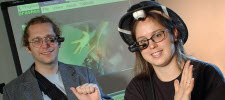Information Architecture and User Experience Bootcamp
Information Architecture, Usability Testing, Interaction Design, User Research
Price: $295 Length: 1 day Student or bulk discounts are available.
This is a practical, hands-on course aimed at people who need to use or understand User Experience techniques.
A: Target Audience
Business Analysts, Developers, Managers, Product Owners, Junior User Experience Professionals; anyone who wishes to learn basic User Experience skills.
B: Course Description
This one-day course teaches basic User Experience skills and techniques. Topics covered are: Interaction Design, Web Issues, Usability Testing, User Research, and major benefits of User Experience design.
Examples and exercises are drawn from web sites, web, desktop, and mobile applications. However, the skills taught are commonly utilized in design of products for all software platforms, from mobile and phone applications through kiosks and larger interactive spaces.
Upon completion of this course the student should:
- Understand approaches and techniques used by Information Architects and Interaction Designers
- Understand both the advantages and pitfalls of each technique
- Have completed exercises in wire framing, developing personas, and other User Experience and Usability procedures
- Know approaches and solutions to specific situations that User Experience professionals and developers may face. For instance, we will examine a way to make pagination easier to use and discuss the use of the Back button in a Rich Internet Application model such as AJAX.
- Know usability and accessibility considerations for situations such as developing appropriate page layout and choosing the proper interactive object.
- Know specific methods to find additional research in these areas.
C: Course Objectives
- To introduce students to the goals and benefits of User Experience Design and techniques used to achieve them.
- To provide students with a toolset of techniques to draw on when creating or evaluating software.
- To provide students with recommendations and solutions to specific problems faced by Interaction Designers, Usability Engineers, and Developers.
- To provide clear references and the skills to gather additional information.
D: Organization
This is a lecture-lab course in which topics are presented by the instructor. Practice techniques are completed by students during the class.
E: Course Topics
- Benefits of Information Architecture and User Experience
- Communicating Design: Wire Frames
- The Purpose of Wire Frames
- How to Read and Create Wire Frames
- Wire Framing exercise
- Shortcomings and alternatives
- Creating Complex Wire Frames: How does Amazon do it?
- Communicating Interactivity: Storyboards and Prototypes
- Requirements and Specifications
- What should we learn about our users? User Research Basics
- Personas: Creating Convincing Personas from User Research
- Exercise: Translating Personas into Design
- Usability Testing:
- What to look for in a Usability Test
- Guidelines and Tips for Effective Testing
- Finding Usability Research
- Interaction Design: Item Placement, Techniques and Standards
- Interaction Design: What is important and where should dI place it?
- Conducting Expert Reviews: Heuristic Evaluations
- Heuristic Evaluation Exercise
- Using Card Sorts to build User-Directed Navigation
- Don’t Lead the User: Interview Techniques
F: About The Instructor:


